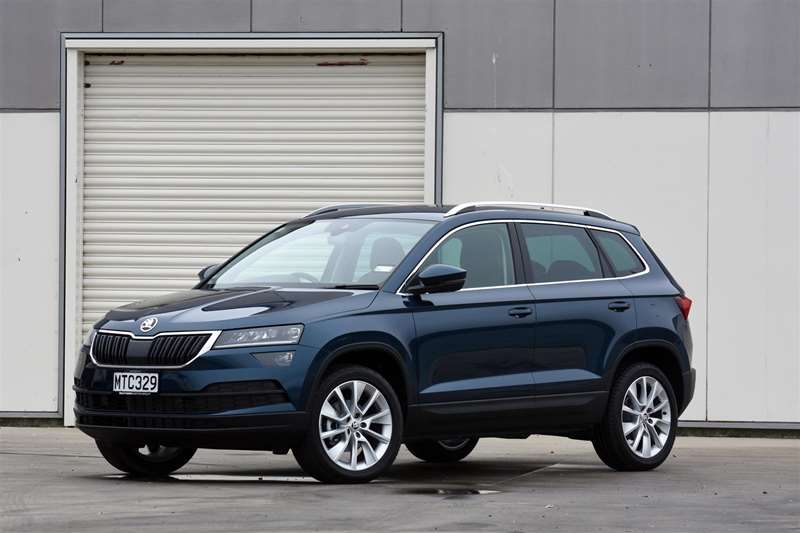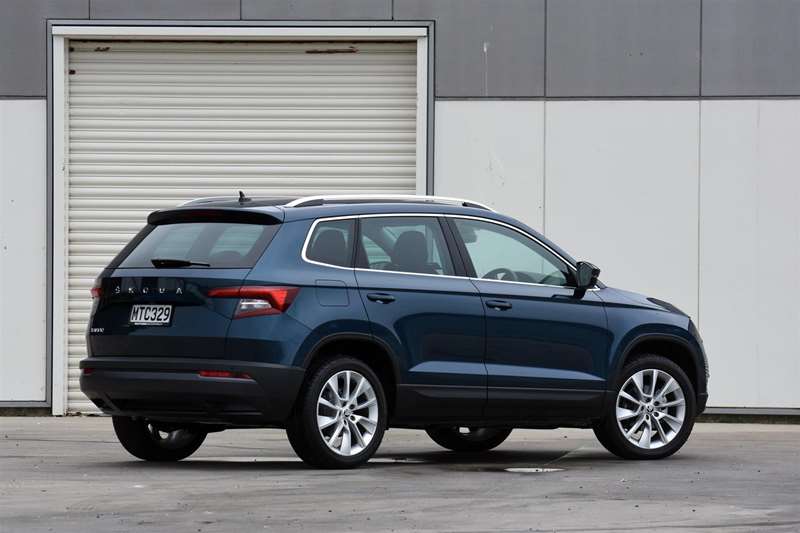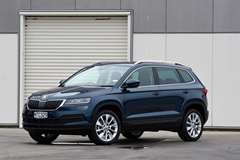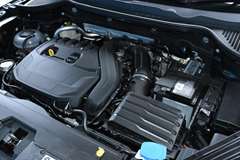Two years after making its debut, the Skoda Karoq mid-sized crossover SUV has been given a tweak for New Zealand. David Thomson tries the petrol variant to see what has changed.
What’s new?
Sometimes progress isnot all that it seems, and suchis the case with the recent change to the New Zealand model range for the Skoda Karoq.
Back in 2018, when the Karoq first appeared as a replacement for the practical but rather quirky Skoda Yeti, two engine options were provided, both mated to a seven speed DSG transmission. One was a 110kW/250Nm 1.5-litre turbo-petrol for front-drive variants, the other a 110kW/340Nm turbo-diesel for four wheel-drive versions.
The turbo-diesel remains in the line-up to power the $50,990 4x4 range flagship, but the 1.5 turbopetrol has been swapped for a 1.4-litre engine inthe $44,990 frontdrive Karoq Style.
The new petrol motor matches its predecessor’s power and torque but— now mated to an eight-speed automatic transmission — it is 15% less fuel efficient.
What’s going on here is that the wider Australasian market of which we are a part has been ‘‘deprioritised’’ for access to the 1.5-litre engine.
Depending on who you believe, this might be because the 1.5 engine is in short supply, and so is being reserved for the Karoq in markets where Euro 6 emissions standards apply and low sulphur fuel (required here, but not in Australia) is mandatory. Or could it be that the wider VW Group of which Skoda is a part feels that Volkswagen’s recently launched T-Cross crossover — a potential rival for the Karoq —should be given the advantage of the more fuel-efficient 1.5-litre motor?
Either way, T-Cross aside, none of the front-drive variants of the several vehicles that loom as the Karoq’s most serious rivals have Euro 6-compliant engines either. Furthermore, only one — the latest Toyota RAV4 2.0 FWD —betters the 1.4-litre Karoq for fuel consumption.
What comes as standard?
The Karoq Style is well provisioned, leading out with a safety package that includes adaptive radar cruise control, lane keeping assistance, side traffic and rear traffic alert. Automated emergency braking front and rear systems are also fitted, along with a reversing camera, cornering lights, heated power mirrors, and rain-sensing wipers.
Inside, a centre touchscreen gives access to satellite navigation and the usual multi-media functions, including smartphone connectivity via the Android Auto and Apple Car Play. There’s also dual zone air conditioning, push button start, and a trip computer accessible via either the main centre display or the digital display within the instrument binnacle.
Various option packs are available, including a panorama sunroof for $2500, and a Plus Pack that adds leather trim, Varioflex rear seats, heated front seats, a heated steering wheel and alloy pedals for $3500. A special Family Pack provides child safety locks, double side floor mats, and a door-mounted rubbish bin for $335.
What’s it like to look at?
Styling is neat and quite conventional, anchored at the front by a nose that has much in common with the larger Kodiaq, and a prominent crease line that runs along the vehicle’s flanks from the top of the LED headlights to the neatly clustered tail-lights.
Being short but also quite wide, and with wheels mounted at the extremities, the Karoq has a nicely planted look on the road. Shod with 215/50 tyres, the 18-inch alloys are a neat fit for the look.
What’s it like inside?
As Drivesouth noted back in 2018, the Karoq has a level ofinterior room you simply wouldn’t pick for a car of its size.
Accessed via a power-operated tailgate on the test car, the boot has an excellent 521-litre capacity with the rear seats raised. The boot is also fitted with an outstanding array of cargo nets, compartments, tie downs and bag hooks to secure items. The boot light can be detached for a torch.
The centre armrest for the rear seat back can be fully opened to serve as a ski flap, and the split-folding rear seats are easily folded down via levers in the boot.Carrying capacity with the rear seats down rises to more than 1810 litres but the rear seat backs sit on top of on the rear squabs when folded and so the space is not flat. The solution to this is to get Varioflex seats that are fully folding and removable. This adds $2350 to the Karoq’s price tag (or $3500 as part of the Plus Pack).
The squabs of the backseats are rather bench-like, but leg and head room is generous. The Karoq’s low waistline gives shorter folk a better view in the back seats than most comparable vehicles.
The power-operated front seats are comfortable and set high enough in the body to provide an elevated driving position, without their being mounted so far up they’re too hard for shorter people to access.
There are plenty of soft-touch surfaces, and the angular set of the dash echoes the vehicle’s exterior styling. When combined with subtle highlighting and light-coloured trim above the waistline, the test car had an appealing interior ambience.
The small main glovebox is augmented by a storage bin with a lid on top of the dashboard. Another handy little covered compartment at the base of the centre console contains 12-volt and USB powering or charging sockets. Dual cupholders and a centre bin/armrest are located between the front seats.
Most key controls are well positioned and easy to use, including the large centre-mounted touchscreen. The cruise control stalk is, however, oddly tucked away to the lower left and behind the steering wheel, so is abit of fiddleto work out initially.
What’s it like to drive?
Standing 1603mm tall, and with 183mm of ground clearance, the Karoq is not exactly low slung. Combining this with well-contained noise levels and a suspension tuned to provide a generously compliant ride, the test car excelled at both round townmotoring and open-road cruising. Radar cruise control and active steering contributed to an easy-going open-road demeanour.
A reasonable amount of body roll is evident when pressing on down winding roads, Despite this, the excellence of the Karoq’s underlying MQB platform (widely use by Audi and VW as well as Skoda) and its well-weighted progressive steering still ensure an engaging drive.
A very smooth-shifting eight-speed automatic transmission is a particular ally for refinement, and manages well as a performance gearbox. There are no paddle shifts, but both a sport mode and Tiptronicstyle manual shifting are accessible from the gear lever.
There is plenty to like in the performance of the new 1.4-litre engine too. Producing, like its predecessor, a peak 250Nm of torque from just 1500rpm, it is responsive from low revs. Skoda claims an 8.8-second 0-100kmh sprint time for the Karoq110 TSI which is reasonable, but it is actually at its most impressive accelerating once the car is already in the move, for snappy highway overtaking.
While traction and stability controls are on hand to rein things in if required, I discovered on test that even quite modest throttle applications can generate a chirp from the front tyres at slow speeds, or induce momentary wheelspin on damp or gritted sections of open road.
Economy-wise, the core section of Drivesouth’s test drive provided a 6.7litres/100km economy return which, while shy of the new petrol Karoq’s 6.3litres/100km standard cycle figure, was respectable enough.
Verdict
If I were to consider owning a Karoq rather than simply testing one, then my preference would be for the 4x4 TDI rather than the front-drive TSI tested here. That’s apreference based on a personal requirement for an SUV that can happilytake gravel, dirt, mud and snow in its stride. Most motorists, of course, do not have this need and so economy aside, the switch of engines has done little to diminish the appeal of the frontdrive petrol version of the Skoda Karoq.
Photos: David Thomson












